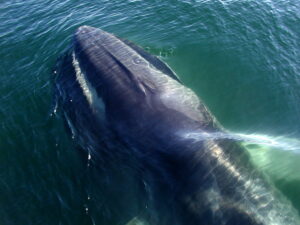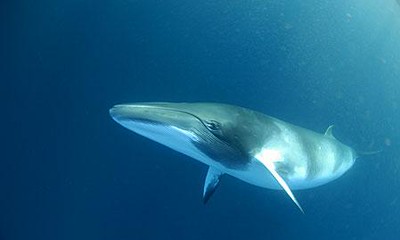Guazzo, R. A., Stevenson, D. L., Edell, M. K., Gagnon, G. J., & Helble, T. A. (2024). A decade of change and stability for fin whale song in the North Atlantic. Front. Mar. Sci. 11, https://doi.org/10.3389/fmars.2024.1278068
Like humans, many marine animals use sound to communicate. Whales are especially known for their remarkable ability to sing, and fin whales (Balaenoptera physalus) in particular have proven to produce low frequency songs. These songs are unique to the ocean in which a whale population lives; in the North Atlantic, for example, whales sing two low-frequency (B) notes followed by a higher frequency (A) note.
However, because whale populations often switch their song patterns, they cannot be identified based on their songs alone. Developing methods that help better understand whale vocalization patterns would provide another way to estimate population numbers, data that is crucial for informing species protection measures.
In this study, researchers attempted to better elucidate fin whale song patterns and how they change, and estimate vocalization rates to learn more about their elusive and fascinating communication skills.
How do you record sound underwater?
Researchers used U.S. Navy arrays to record fin whale songs in the North Atlantic over a ten year period. Fin whales were tracked manually and then recorded using multiple hydrophones (underwater microphones). This method led to the collection of 299 hours of recordings. Detectors that quantified the frequency of songs also captured the start and end time of signals, which was later used to determine note type, classified as A or B. Song patterns were also classified according to the intervals recorded between notes (also called inter-note intervals or INIs), with “singlet” referring to constant INIs and “doublet” referring to two alternate INIs.
What did they hear?
The 299 hours of song recorded included over 66,000 A and B notes, making up four different song patterns: A-B doublet (median of 10 s between first notes and 11s between second), A-A singlet (median of 25 s between notes), B-B singlet (median of 13 s between notes), and B-B doublet (median of 12 s between first notes and 20s between second). A-A singlet was the most rare of these patterns. Vocalization rates ranged from 90 notes/hr to 332 notes/hr but showed no clear trend over the ten year period.
Why do INIs happen?
The results of this study support a previous hypothesis that long INIs between notes correspond to the times that whales surface, especially when a whale runs into another singer.
There were some noticeable changes in the INIs of each song pattern over time: B-B doublet INIs increased from 2019-2023 and A-B doublet INIs increased within each year, between summer and spring, and returned to their original length in the summer. The reason for the difference between INI lengths in each song pattern and location is not yet known, however researchers suggest that this may be due to changes in fin whale population density, meaning that an increase in population would cause whales to reduce their own vocalizations in an effort to allow others to sing. Alternatively, some suggest that male fin whales’ testosterone levels might increase each season like humpback whales’ are known to, which could be connected to vocalization rates and patterns.

Fin whale. Image credits: Chris Buelow via Flickr Creative Commons
While new song patterns were identified in this study, the exact location of different songs could not be determined; therefore there was no way for researchers to know whether variations were due to geography, population, or individuals. Most of the songs identified in this study were consistent with songs found in similar studies, even in other oceans, although the interval lengths between notes recorded here differed from those found in other reports. The nuances in singing behavior found in this study, however, had not been previously reported at all.
The decrease in frequency of notes that was observed throughout this study could be due to physiological limits, sexual selection, population recovery efforts, or song synchronization.
Finally, although this study aimed to discover more whale song patterns to help determine species abundance, they were only able to estimate the number of vocally active whales rather than quantify the total population.
What’s next?
Future studies should apply methods previously used to elucidate vocalization patterns of other whale species, like the humpback and blue whale, to the lesser understood fin whale. Specifically, efforts should focus on expanding these methods to different locations, collecting more long-term data, discovering new note types and frequencies, and observing behavior that occurs while whales produce songs. Such information would improve our understanding of underwater communication, whale connectivity, and fin whale population estimates and distribution, and could thus inform future whale conservation and protection efforts.
Cover photo by Amila Tennakoon on Flickr Creative Commons

I received my MPS in Marine Biology & Ecology from the University of Miami’s Rosenstiel School of Marine, Atmospheric, and Earth Sciences in May 2024. I plan to use my education and experience to pursue a career in science writing or film production to help communicate the importance of the ocean to the general public.


